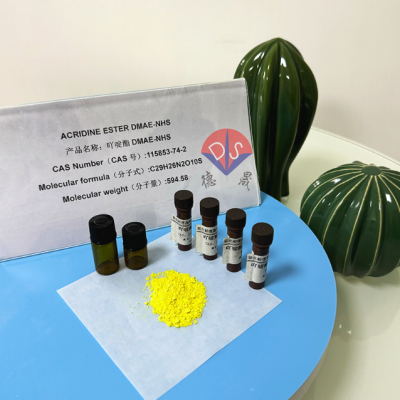Home > Products > Chemiluminescence reagent > Direct Chemiluminescence of Acridine Ester DMAE-NHS 115853-74-2
Direct Chemiluminescence of Acridine Ester DMAE-NHS 115853-74-2
≥10 Milligrams
- Shanghai
- T/T L/C
- 5 days
You May Like
-
Detailed Introduction of Luminescent Reagent NSP-SA 211106-69-3
-
Stability and Precautions of Acridine Ester (NSP-SA-NHS)
-
The Labeling Principle and Application of Acridine Hydrazide NSP-SA-ADH
-
Application and pH Stability of Acetyl CoA Oxidase
-
Tris and Glutamate Dehydrogenase Work Together on Homocysteine Assay Kit
-
The Relationship Between Purine Nucleoside Phosphorylase and Nucleic Acid Synthesis and Decomposition
Product Details
| CAS No. | 115853-74-2 | Application | Scientific Research | |
| Usage | Laboratory Reagents, Analytical Reagents, Diagnostic Reagents | Property | Biochemical Reagent | |
| Classification | High Purity Material | Grade | AR |
Product Description
Acridine ester DMAE-NHS is an important chemiluminescent reagent that can achieve conjugated labeling by reacting with amino groups in biomolecules, thus used for detecting the presence and quantitative analysis of biomolecules. At the same time, due to its direct luminescent properties, it is widely used in the field of biomedical research. Below, we will focus on analyzing the chemical properties, direct luminescence mechanism, and applications of acridine ester DMAE-NHS in biomedical research.
1、 Acridine ester DMAE-NHS direct luminescence
Acridine ester DMAE-NHS is a solid powder, typically yellow in color, that dissolves well in dry organic solvents such as dimethyl sulfoxide (DMSO) and dimethylformamide (DMF). It belongs to acridine ester compounds and has direct luminescence properties. Its direct luminescence mechanism involves the excitation of light, causing the acridine ester DMAE-NHS molecule to undergo a transition from the excited state to the ground state, resulting in luminescence. This direct luminescence property makes it an excellent chemiluminescence reagent suitable for analyzing the presence and content of biomolecules.
2、 Application of Acridine Ester DMAE-NHS in Biomedical Research
As a chemiluminescence reagent, it has a wide range of applications in biomedical research and can react with amino groups in biomolecules such as proteins, antibodies, and oligonucleotides to achieve conjugated labeling. By conjugated labeling with target biomolecules, chemiluminescence technology can be used for detection and quantitative analysis, thereby achieving research and analysis of biomolecules.
3、 Advantages and limitations of acridine ester DMAE-NHS
Acridine ester DMAE-NHS has many advantages as a chemiluminescence reagent, such as direct luminescence properties, high sensitivity, and wide detection range. In addition, it can react with amino groups in various biomolecules to achieve diverse labeling and detection. However, it also has some limitations, such as the possibility of background interference in some complex biological systems, which requires optimization and control based on specific experimental conditions.
Acridine ester DMAE-NHS, as an important chemiluminescence reagent, has direct luminescence properties and is suitable for labeling and detecting biomolecules in biomedical research. Its chemical properties are stable and easy to operate, providing powerful tools for biochemical experiments and biomedical research.
As a supplier of luminescent reagents, Desheng not only offers the product DMAE-NHS of acridine ester, but also has 5 different groups of acridine esters to choose from to meet different experimental conditions. Due to direct supply and no third-party sales, agents can be exempted from making price differences, helping customers save costs. If you are interested, please feel free to contact us at any time to make a purchase!
Contact Us

- Hubei New Desheng Material Technology Co., Ltd
- Contact nameDoris Yang Chat Now
Product Categories
| Additive for blood collection | Biological buffer | Chemiluminescence reagent | Chromogenic substrate |
| enzyme preparation |
New Products
-
Introduction of Desheng on Alpha Glucosidase
-
Glucose Dehydrogenase: a Key Enzyme in IVD in Vitro Diagnostic Reagents
-
Detailed Explanation of Storage Methods for Adenosine Deaminase (ADA)
-
Biological Functions and Applications of Malate Dehydrogenase
-
The Price of TRIS-HCL 1185-53-1 Produced by Desheng Has Been Lowered. Please Feel Free to Consult and Purchase
-
Why Should we Pay Attention to Solubility When Purchasing Biological Buffer TRIS 77-86-1?
-
The Effect of Purity of BICINE Powder 150-25-4 as a Biological Buffer on the Performance of Buffer Solutions
-
Introduction to the Transportation Packaging of CAPS Powder 1135-40-6, a Biological Buffering Agent
-
Compatibility of Biological Buffer MOPS 1132-61-2 With Other Reagents
-
Application of Biological Buffer TAPS 29915-38-6 in Enzyme Activity Research
-
The Advantage of High Purity of EPPS Powder 16052-06-5 Raw Materials for Biological Buffering Agents
-
Advantages of MOPSO Buffer 68399-77-9 in Low-temperature Biochemical Work
-
What Does HEPES Buffer 7365-45-9 do for Cell Culture
-
Application of Biological Buffer PIPES 5625-37-6 in Biochemical Research
-
How to Determine and Choose a BES Buffer 10191-18-1 Manufacturer for Procurement
-
Biological Buffer DIPSO (68399-80-4) Detailed Description for Quick Understanding
-
Multiple Applications of CHES Buffer in Biological Research
-
Advantages of High TOOS Molar Absorbance
-
How to Obtain High-quality TOPS Powder as a Chromogenic Substrate
-
Stability and Storage Conditions of ADOS Products as Chromogenic Substrates
-
The Simplicity of ADPS Colorimetric Reagent in Experimental Operation
-
Packaging Requirements for Exporting Color Developing Substrate ALPS Powder in Small Batches
-
What Items Can DAOS, a Chromogenic Substrate, be Used to Detect?
-
Basic Information of the New Trinder's Reagent HDAOS Powder Reagent
Popular Searches
Recommended Products
- Air and Environmental On-Site Testing Items Table
- Water Sample Mercury Ion (Hg²⁺) Concentration Assay Kit
- Nitrite Test Paper 0~100 Ppm
- On Site Rapid Detection of Surface Cleanliness of Catering Utensils
- Sodium Metasilicate Granular 25kg Powder
- Chlorine Dioxide Quick Test Kit
- Residual Chlorine Quick Test Kit
- Rapid Determination of Available Chlorine
- Quaternary Ammonium Sanitizer Concentration Test Strips [0~4000 Ppm]
- Quaternary Ammonium Sanitizer Concentration Test Strips [0~1000 Ppm]
- You Need to Pay Attention to These Three Erroneous Views When Purchasing Carbopol Powder
- Exploration of the Advantages of MAOS Chromogenic Substrates in Biochemical Detection
Find Similar Products By Category
- Chemicals > Chemical Reagent
- Please Enter your Email Address
- Please enter the content for your inquiry.
We will find the most reliable suppliers for you according to your description.
Send Now-
 Doris Yang
Hi there! Welcome to my shop. Let me know if you have any questions.
Doris Yang
Hi there! Welcome to my shop. Let me know if you have any questions.
Your message has exceeded the limit.

- Contact supplier for lowest price
- Customized Request
- Request Sample
- Request Free Catalogs
Your message has exceeded the limit.
-
Purchase Quantity
-
*Sourcing Details
Your inquiry content must be between 10 to 5000 characters.
-
*Email
Please enter Your valid email address.
-
Mobile





